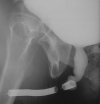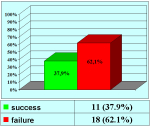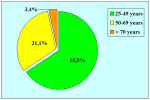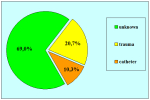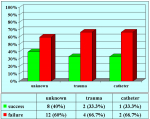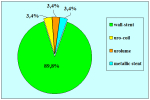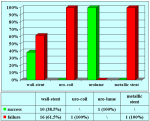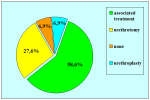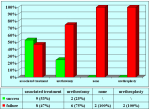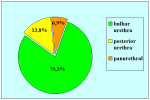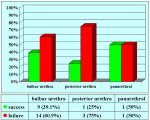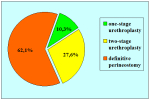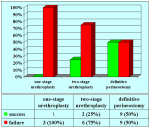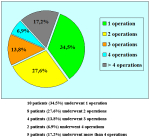The first to use stent in the urethra was Fabian, who placed a metal stent in the prostate in 1980.
These stent had the disadvantage of incrustation, dislocation, and recurrent infection. In 1996, Milroy first described a new type of urethral stent. Referring to the experience gained with stents in cardiology after angioplasty, they developed a stent that holds opened the previously dilated urethra while becoming covered with urethral epithelium. After this pioneering work, a number of modified stents were developed.
These stents are easy to place under local anaesthesia. The stent should be placed at least 0,5 cm from the external sphincter to avoid urinary incontinence. Stents should not be used in the penile urethra, due to their mobility.
The most frequent complications after stent implant are: incrustations, stones, dislocation, perineal pain, haematuria, incontinence, recurrent urinary tract infection and recurrent stricture. The stricture may locate at the distal or proximal part of the stent or inside the stent due to grow of inflammatory tissue between the links of the stent with obstructive symptoms or urinary retention.
In the majority of patients the endoscopic removal of the stents not possible due to grow of the tissue inside the stent.
Surgical removal of urethral stent still represents a challenging problem in urology. In some patients, to remove the stent is possible only completely removing the urethra around it. In other patients, the stent is removed link by link, leaving the urethral plate intact. The surgical reconstruction of the urethra, after the stent removal, is performed using a one-stage oral mucosal graft urethroplasty or a staged urethral reconstruction. Anyway, the surgical removal of urethral stent always represents a challenging problem and should be referral to a specialized centre.
These stent had the disadvantage of incrustation, dislocation, and recurrent infection. In 1996, Milroy first described a new type of urethral stent. Referring to the experience gained with stents in cardiology after angioplasty, they developed a stent that holds opened the previously dilated urethra while becoming covered with urethral epithelium. After this pioneering work, a number of modified stents were developed.
These stents are easy to place under local anaesthesia. The stent should be placed at least 0,5 cm from the external sphincter to avoid urinary incontinence. Stents should not be used in the penile urethra, due to their mobility.
The most frequent complications after stent implant are: incrustations, stones, dislocation, perineal pain, haematuria, incontinence, recurrent urinary tract infection and recurrent stricture. The stricture may locate at the distal or proximal part of the stent or inside the stent due to grow of inflammatory tissue between the links of the stent with obstructive symptoms or urinary retention.
In the majority of patients the endoscopic removal of the stents not possible due to grow of the tissue inside the stent.
Surgical removal of urethral stent still represents a challenging problem in urology. In some patients, to remove the stent is possible only completely removing the urethra around it. In other patients, the stent is removed link by link, leaving the urethral plate intact. The surgical reconstruction of the urethra, after the stent removal, is performed using a one-stage oral mucosal graft urethroplasty or a staged urethral reconstruction. Anyway, the surgical removal of urethral stent always represents a challenging problem and should be referral to a specialized centre.
|
Figure 1 |
Figure 2 |
Figure 3 |
Figure 4 |
|
Figure 5 |
Figure 6 |
Figure 7 |
Figure 8 |
Article n° 1
Barbagli G, Palminteri E, Guazzoni G, Rigatti P.
Surgical removal of urethral stents.
J. Urol., 1999: 161 (4), 102
Article n° 2
Barbagli G, Travaglini F, Palminteri E.
Surgical removal of urethral stents.
Eur. Urol., 1999: 35 (Suppl. 2), 154
Barbagli G, Palminteri E, Guazzoni G, Rigatti P.
Surgical removal of urethral stents.
J. Urol., 1999: 161 (4), 102
Article n° 2
Barbagli G, Travaglini F, Palminteri E.
Surgical removal of urethral stents.
Eur. Urol., 1999: 35 (Suppl. 2), 154
1. Question: What kind of anesthesia is used for this surgery?
Answer: General anesthesia with oro-tracheal intubation or nasal intubation.
2. Question: How many hours does the surgery take?
Answer: About 2 hours.
3. Question: Are there any risks concerning erection, fertility and continence after the surgery?
Answer: No.
4. Question: How many days of hospital recovery are expected following the surgery?
Answer: In general, from 5 to 7 days.
5. Question: How long will I have to use a urethral catheter following surgery?
Answer: The urethral catheter must stay in place for two or three weeks following surgery.
6. Question: Are there any particular recommendations during convalescence?
Answer: During convalescence, antibiotic use is suggested until the catheter is removed. It is also suggested that long car trips be avoided, as well as heavy labor, sexual activity and sports.
7. Question: When will I be able to resume work, sexual activity and sports?
Answer: All these activities can be gradually resumed after the removal of the catheter.
8. Question: Can I ride a bike or a motorcycle immediately after the surgery?
Answer: It is not recommended to ride bikes, motorcycles or horses after the surgery.
9. Question:: What kinds of foods and drinks should be avoided after the surgery?
Answer: Beer and sparkling wines should be avoided, as well as large quantities of chocolate, cocoa, nuts and shellfish.
Answer: General anesthesia with oro-tracheal intubation or nasal intubation.
2. Question: How many hours does the surgery take?
Answer: About 2 hours.
3. Question: Are there any risks concerning erection, fertility and continence after the surgery?
Answer: No.
4. Question: How many days of hospital recovery are expected following the surgery?
Answer: In general, from 5 to 7 days.
5. Question: How long will I have to use a urethral catheter following surgery?
Answer: The urethral catheter must stay in place for two or three weeks following surgery.
6. Question: Are there any particular recommendations during convalescence?
Answer: During convalescence, antibiotic use is suggested until the catheter is removed. It is also suggested that long car trips be avoided, as well as heavy labor, sexual activity and sports.
7. Question: When will I be able to resume work, sexual activity and sports?
Answer: All these activities can be gradually resumed after the removal of the catheter.
8. Question: Can I ride a bike or a motorcycle immediately after the surgery?
Answer: It is not recommended to ride bikes, motorcycles or horses after the surgery.
9. Question:: What kinds of foods and drinks should be avoided after the surgery?
Answer: Beer and sparkling wines should be avoided, as well as large quantities of chocolate, cocoa, nuts and shellfish.
| Up-to-date to 12-31-2021 | |||

PDF Summarizing table |
|||

